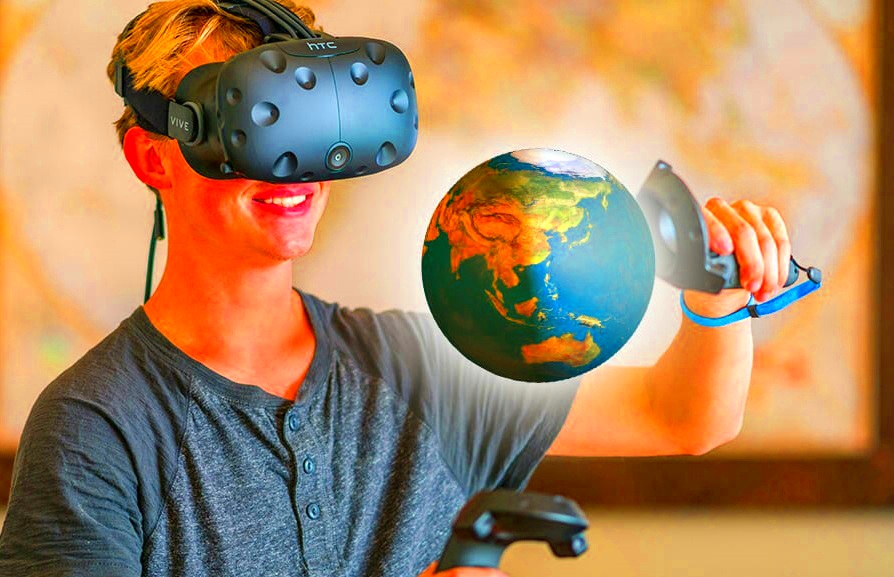Augmented Reality (AR) has grown into a highly sought-after technology, and with it, the demand for AR developers has risen. As a freelance AR developer, you get the flexibility to work on innovative projects for various industries. Whether it's creating AR apps, virtual try-ons, or enhancing customer experiences, the possibilities are endless. This guide will walk you through the basics of starting your career as a freelance AR developer, from understanding your role to building a strong portfolio and finding clients. If you're passionate about blending technology with creativity, this could be the perfect career path for you.
Understanding the Role of an Augmented Reality Developer

An Augmented Reality developer creates immersive digital experiences that blend virtual objects with the real world. The role involves coding and designing AR applications across multiple platforms, including mobile devices, AR glasses, and more. Here’s a breakdown of key responsibilities:
- Creating AR Applications: Developing apps that incorporate 3D models and interactive content into real-world environments.
- Designing User Experiences: Ensuring the user interface (UI) and user experience (UX) are smooth and intuitive.
- Working with AR Frameworks: Using AR development platforms like ARKit (for iOS) and ARCore (for Android) to create immersive experiences.
- Collaborating with Other Professionals: Working alongside designers, product managers, and other developers to bring AR projects to life.
As an AR developer, your work will often involve both technical skills (coding, 3D modeling) and creative skills (designing the AR environment and interactions). It's a dynamic field where your role will continue to evolve with advancements in technology.
Also Read This: Top 10 wordpress developer on fiverr
Essential Skills for Becoming a Freelance AR Developer

To become a successful freelance AR developer, there are several key skills you'll need to master. Here's a breakdown:
- Programming Languages: Knowledge of languages like C#, C++, and JavaScript is essential for building AR applications. These languages are commonly used in AR frameworks.
- Familiarity with AR Platforms: Being proficient in platforms like Unity3D, Unreal Engine, ARKit, and ARCore is vital. These platforms provide the tools needed to create and deploy AR experiences.
- 3D Modeling and Animation: A good understanding of 3D modeling tools like Blender or Maya will help you create realistic objects and animations for AR environments.
- UX/UI Design: Since AR apps need to be user-friendly, having design skills will allow you to create seamless interactions for users in a 3D space.
- Problem-Solving: AR development often involves troubleshooting and optimizing the user experience, so strong problem-solving skills are a must.
Beyond technical skills, as a freelancer, you'll also need good communication, time management, and business skills. Building strong client relationships and managing multiple projects are key to maintaining a successful freelance career in AR development.
Also Read This: How to Get Fiverr Order Easily in 2019
Steps to Get Started as a Freelance Augmented Reality Developer

If you're looking to dive into freelance augmented reality (AR) development, there are a few important steps to get you started. The good news is that with the right knowledge and tools, you can build a successful career. Here’s a simple guide to help you begin:
- Learn the Fundamentals: First, make sure you have a solid understanding of the basics of AR technology. Familiarize yourself with AR platforms, programming languages, and development tools. It's crucial to be comfortable with ARKit, ARCore, Unity, or Unreal Engine.
- Build a Portfolio: Showcase your skills by creating a portfolio of your AR projects. Start with small, simple apps or concepts to demonstrate your capabilities. This portfolio will become your best asset when reaching out to potential clients.
- Invest in Tools: As a freelance AR developer, you'll need to have the right equipment. A good computer, the necessary software tools, and AR-capable devices (such as smartphones or AR glasses) will be essential for testing your work.
- Start Small with Freelance Projects: Look for entry-level freelance projects on platforms like Fiverr or Upwork. These initial jobs will help you build experience, learn how to handle clients, and set your rates.
- Stay Updated with AR Trends: The AR field is constantly evolving, so it's important to stay current with the latest trends, tools, and techniques. Follow AR-related blogs, attend webinars, and engage with the AR development community to keep your skills fresh.
Also Read This: What Does a Down Arrow Mean on Fiverr? Understanding the Symbol and Its Implications
How to Build a Strong Portfolio as an AR Developer
Your portfolio is one of the most important tools for attracting clients as a freelance augmented reality developer. It showcases your skills and demonstrates what you can bring to the table. Here’s how you can create a portfolio that stands out:
- Start with Personal Projects: If you’re just starting out, create AR apps or projects that interest you. It doesn’t matter if they are small—showing your creativity and technical ability matters more.
- Highlight Your Best Work: Choose your most impressive and relevant projects to showcase. Potential clients want to see the quality of your work, so make sure each project reflects your skill set.
- Showcase Variety: Display a range of AR projects. This could include interactive marketing experiences, games, or educational AR apps. The more diverse your work, the more clients you’ll attract across different industries.
- Provide Context and Results: Don’t just show the finished product. Include a brief description of each project—what the problem was, how you solved it, and the outcomes. This shows potential clients that you understand both the technical and business sides of AR development.
- Keep It Updated: Always add new work to your portfolio. As you complete more projects, refresh your portfolio to reflect your current abilities and experience.
Remember, a well-curated portfolio not only demonstrates your skills but also sets the tone for how clients perceive you. Make it professional, organized, and easy to navigate.
Also Read This: How to Put a Credit Card in Fiverr for Sellers
Finding Clients and Marketing Your AR Development Services
- Join Freelance Platforms: Websites like Fiverr, Upwork, and Freelancer are excellent platforms to start offering your services. These platforms allow you to find clients actively seeking AR developers. Be sure to create a detailed profile highlighting your skills and experience.
- Leverage Social Media: Use platforms like LinkedIn, Twitter, and Instagram to promote your work and network with potential clients. Share your projects, AR demos, and insights about AR technology to position yourself as an expert.
- Create a Personal Website: A professional website can act as your business card online. It should showcase your portfolio, include client testimonials, and have a clear contact form. This will help you establish credibility and attract direct clients.
- Network with Industry Professionals: Attend industry conferences, webinars, and AR-related meetups to connect with other professionals in the field. Many clients are referred through word of mouth, so networking is a great way to expand your opportunities.
- Offer Free or Discounted Services to Build Reputation: When you’re starting out, offering discounted or even free services for a limited time can help you gain experience and build positive client reviews.
Marketing yourself as an AR developer requires consistent effort, but with the right approach, you'll gradually build a loyal client base. Focus on your skills, network effectively, and always be open to learning and growing in the AR field.
Also Read This: Costs for Card Authentication on Freelancer
Setting Your Rates and Managing Freelance Projects
Setting the right rates and managing your freelance projects effectively are essential for running a successful freelance AR development business. When you're starting, it can be tricky to figure out what to charge and how to keep projects on track. Here's a guide to help you manage both:
- Determine Your Rate: To set your rate, consider your experience level, the complexity of the project, and industry standards. Research what other AR developers are charging on freelance platforms like Fiverr and Upwork. For a starting point, you can charge hourly or offer fixed-rate pricing depending on the project scope.
- Calculate Your Costs: Don't forget to factor in your expenses, like software subscriptions, equipment, and taxes, when setting your rates. Make sure your rate is high enough to cover these and still leave you with a profit.
- Be Transparent with Clients: Always communicate your rates clearly upfront. Provide detailed estimates for each project and discuss any additional costs that may arise during the development process.
- Manage Multiple Projects: As a freelancer, you’ll likely juggle several projects at once. Using project management tools like Trello or Asana can help you track deadlines, client communication, and project milestones.
- Set Milestones and Deadlines: Break down your projects into manageable tasks and set deadlines for each. This will help you stay on track and deliver projects on time. It’s also a great way to show clients your professional approach to project management.
- Review Contracts and Invoices: Before starting any project, always create a clear contract outlining deliverables, timelines, and payment terms. Use invoicing software like FreshBooks or QuickBooks to keep track of payments and manage your freelance business finances.
By being strategic about your rates and managing your projects well, you’ll set yourself up for long-term success as a freelance AR developer.
Also Read This: Becoming a Freelance Engineer
FAQ
1. How do I find clients as a freelance AR developer?
You can find clients by joining freelance platforms like Fiverr or Upwork, networking on LinkedIn, and creating a personal website to showcase your portfolio. Networking at AR events and online communities can also help connect you with potential clients.
2. What is the average rate for an AR developer?
The rates vary based on your experience, project complexity, and location. Beginners might charge around $25–$50 per hour, while experienced AR developers can charge $100 or more per hour. Research what others in your field are charging to find a competitive rate.
3. Do I need to know 3D modeling to be an AR developer?
While it’s not mandatory, having knowledge of 3D modeling is very helpful in AR development. Many AR applications involve integrating 3D objects into the real world, so understanding 3D design tools like Blender or Maya can be a significant asset.
4. How long does it take to build an AR application?
The timeline for building an AR app depends on the project’s complexity. Simple AR apps might take a few weeks, while more complex applications could take several months to develop. Clear communication with your clients about deadlines is essential for managing expectations.
5. Can I freelance as an AR developer part-time?
Yes! Many freelancers work part-time while building their portfolios. You can start with smaller, part-time projects while you gain experience and then gradually increase your workload as you become more comfortable with the process.
Conclusion
Becoming a freelance augmented reality (AR) developer can be an exciting and rewarding career path. With the right skills, a strong portfolio, and an understanding of how to find clients and manage projects, you can carve out a successful freelance business. While getting started can feel overwhelming, taking small steps to learn the necessary tools, build your portfolio, and establish your rates will pay off in the long run.
As AR technology continues to grow, the demand for skilled developers will also rise. Whether you’re just starting or already have some experience, there are plenty of opportunities to thrive in this innovative field. Stay dedicated, keep learning, and always be ready to adapt to new trends and technologies. The future of AR development is bright, and as a freelancer, you have the flexibility to shape your own path in this exciting industry.




